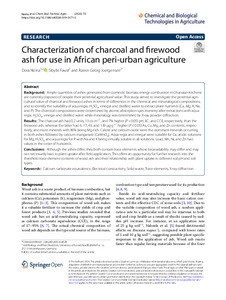| dcterms.abstract | Background
Ample quantities of ashes generated from domestic biomass energy combustion in Ghanaian kitchens are currently disposed of despite their potential agricultural value. This study aimed to investigate the potential agricultural value of charcoal and firewood ashes in terms of differences in the chemical and mineralogical compositions, and to identify the suitability of aqua regia, H2SO4, vinegar and distilled water to extract plant nutrients (Ca, Mg, K, Na, and P). The chemical compositions were determined by atomic absorption spectrometry after extractions with aqua regia, H2SO4, vinegar and distilled water while mineralogy was determined by X-ray powder diffraction.
Results
The charcoal ash had 0.2 units, 13 ds m−1, and 7% higher (P < 0.05) pH, EC, and CCE, respectively, than the firewood ash, whereas the latter had 6, 17, 43, and 139 µg g−1 higher (P < 0.05) As, Cu, Mg, and Zn contents, respectively, and more minerals with 86% being Mg-rich. Calcite and calcium oxide were the dominant minerals occurring in both ashes followed by calcium manganate (CaMnO3). Aqua regia and vinegar were suitable for Ca, acidic solutions for Mg, H2SO4 and aqua regia for P with Na and K being virtually soluble in all solutions. Lead, Mn, Ni, and Zn had values in the order of hundreds.
Conclusions
Although the ashes differ, they both contain trace elements whose bioavailability may differ and may not necessarily lead to plant uptake after field application. This offers an opportunity for further research into the threshold trace element contents of wood ash and their relationship with plant uptake in different soil pH and soil types. | eng |


